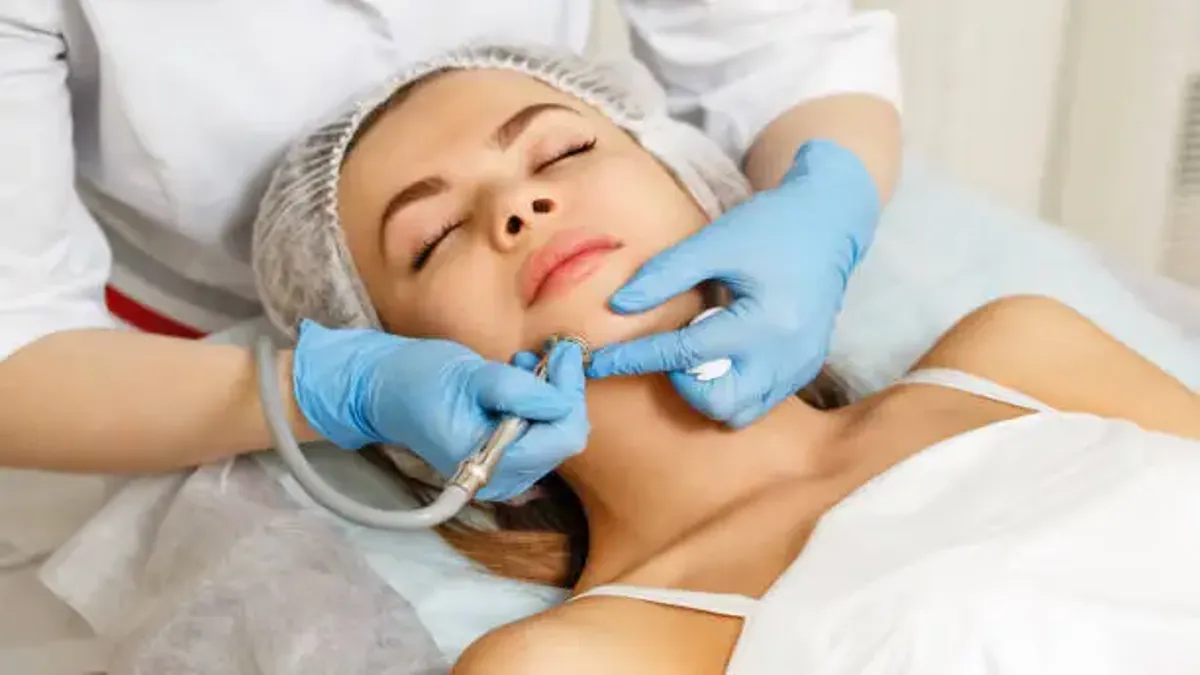Microdermabrasion is a non-invasive cosmetic procedure designed to exfoliate the outermost layer of the skin, improving texture, tone and radiance through controlled mechanical abrasion. Over the last several decades, it has become a widely used aesthetic technique for those seeking gentle resurfacing with minimal downtime. But with the abundance of marketing promises, evolving technologies, and competing treatments, many people ask: what can microdermabrasion realistically achieve, and where does it fall short? This article provides a comprehensive and deeply reported overview of the treatment—its mechanisms, historical development, clinical evidence, limitations, risks and aftercare considerations—so readers can understand its true role in modern dermatology.
By tracing its origins, evaluating key clinical studies, and comparing professional versus at-home options, this guide aims to position microdermabrasion not as a miracle solution but as a scientifically grounded technique best suited for specific skin concerns. Through expert quotes, structured tables and documented insights, the following sections explore what the treatment can do, what it cannot, and how individuals can integrate it into a wider and more informed skin-care plan.
Origins and Mechanism
When microdermabrasion emerged in the 1980s, it was celebrated as a gentler alternative to dermabrasion and deep chemical peels. Early devices relied on aluminium-oxide crystals combined with suction to remove the outer layer of the epidermis. Research underscored that the action primarily occurs at the stratum corneum, where mechanical disruption triggers mild inflammation and stimulates new cell turnover. Studies later showed that while epidermal thickness may not significantly change, collagen organization can improve over time in cases of mild scarring or photoaging. These changes reflect micro-injury and controlled healing, which are central to the technique’s effect. Although its outcomes are modest, microdermabrasion’s low risk and accessibility have made it a durable option for texture improvement and maintenance-based skin rejuvenation.
Evidence of Effectiveness
Clinical studies consistently describe microdermabrasion’s benefits as mild to moderate, rather than transformative. In comparative research between microdermabrasion and glycolic acid peels, outcomes were often similar, with a portion of participants achieving “good improvement” only after a series of sessions. Histometric evaluations have shown reduced melanization and more organized collagen bundles, though the researchers themselves characterize the results as subtle. Other overviews highlight its usefulness in smoothing tone, refining pores and preparing the skin for enhanced topical absorption. Yet these findings also emphasize that the results depend on repetition and are best suited for early signs of aging or superficial skin irregularities—not deep scars or pronounced wrinkles.
Candidacy and Suitability
Microdermabrasion’s gentle approach means it is compatible with many skin types, including darker tones, but it is not universally ideal. Those with rosacea, active skin infections, broken capillaries, or uncontrolled acne may experience irritation or adverse effects. Conversely, individuals with mild texture concerns, dullness, or superficial pigmentation often find that microdermabrasion offers a cost-efficient, low-downtime improvement. Dermatologists repeatedly stress the importance of managing expectations: the treatment produces subtle changes that accumulate over multiple visits. If a person seeks dramatic resurfacing or significant scar revision, more intensive modalities—such as lasers or stronger peels—are generally more appropriate.
Professional vs. At-Home Treatment
A widening market of devices has created a divide between clinical and at-home microdermabrasion. Professional systems employ stronger suction, more precise diamond tips or higher-grade crystals, all of which produce more noticeable outcomes under the supervision of trained practitioners. At-home tools can be effective for maintenance, but their reduced intensity and greater dependence on user technique create a higher margin for misuse. While some research has found home devices safe and beneficial, experts note that patients increasingly gravitate toward treatments offering longer-lasting or more dramatic results, which may explain microdermabrasion’s slight decline in popularity compared with newer technologies.
Table: Indications and Typical Outcomes
| Skin Concern | Expected Improvement | Limitations |
|---|---|---|
| Fine lines and texture irregularity | Smoother feel, mild softening | Deeper wrinkles remain unchanged |
| Uneven skin tone or mild pigmentation | Brighter tone, slight reduction in irregularity | Not suitable for deep or stubborn pigment spots |
| Superficial acne scarring | Fair improvement after repeated sessions | Ineffective for deeper, indented scars |
| Enlarged pores and dullness | Immediate glow, refined surface | Effects require ongoing maintenance |
Table: Clinical vs Home-Use Comparison
| Attribute | Professional Treatment | At-Home Devices |
|---|---|---|
| Abrasion Strength | High and precisely controlled | Mild to moderate |
| Safety Structure | Oversight by trained practitioner | Variable: dependent on user skill |
| Cost | Higher per session | Lower initial investment |
| Speed of Visible Results | Faster and more pronounced | Slower, gradual |
| Risk Level | Low when properly administered | Higher risk of irritation or misuse |
Risks, Aftercare and Safety Considerations
Microdermabrasion’s relative safety is one of its strongest attributes, yet even mild procedures require proper preparation and aftercare. Temporary redness, swelling or flaking are normal. More concerning complications—such as post-inflammatory hyperpigmentation or infection—typically arise only with misuse or preexisting skin instability. Dermatologists recommend avoiding retinoids, acids or intense sun exposure immediately after treatment. Adequate moisturization and high-SPF sunscreen are essential. As clinical overviews repeatedly note, proper training—whether for practitioners or consumers using home devices—is essential to ensure safety and effectiveness.
Alternatives and Complementary Treatments
In recent years, other resurfacing and exfoliation technologies have shifted consumer preferences. Chemical peels, hydradermabrasion, radiofrequency, and fractional lasers offer deeper and longer-lasting results, though they come with higher cost and more downtime. For many, microdermabrasion now functions less as a stand-alone solution and more as a complementary technique—refreshing the skin between more intensive procedures. Some clinics use it to enhance topical delivery of vitamin C, peptides, or pigment-correcting serums, taking advantage of the temporary increase in absorption created by barrier disruption.
Clinical Conversations: Questions to Ask
When considering microdermabrasion, individuals benefit from an informed dialogue with their clinician. They should ask how many sessions are recommended, what level of abrasion will be used, what outcomes are realistic, and whether their skin type—particularly if darker or sensitive—is well suited to the treatment. Dermatologists consistently emphasize that while microdermabrasion is safe and accessible, its results remain subtle. The goal is to avoid unrealistic expectations and tailor the procedure to specific concerns, rather than hoping for comprehensive resurfacing.
Skin of Colour and Sensitive Skin Considerations
Patients with darker skin tones or reactive skin should be approached with care. While microdermabrasion is generally considered safe across a range of skin types, individuals with a history of hyperpigmentation, melasma, or keloid formation require cautious settings and gradual progression. Studies from diverse populations show positive outcomes when administered by experienced practitioners, highlighting the importance of dermatologic expertise and cultural competence. Sensitive-skin clients may also require milder passes and extended intervals between treatments.
Future Research and Evolving Techniques
Foundational studies from the 2000s revealed the molecular and structural changes stimulated by microdermabrasion, including collagen remodeling and cell turnover. More recent advancements in imaging and three-dimensional skin-surface analysis aim to quantify improvements with greater precision. Microdermabrasion may further evolve as it integrates with combination therapies, newer device technologies, and refined techniques. Despite competition from more powerful treatments, its relevance persists: gentle resurfacing, minimal downtime, and a consistent safety record ensure its enduring role in modern dermatology.
Takeaways
- Microdermabrasion removes the skin’s outer layer to improve texture, brightness and mild irregularities.
- Clinical outcomes are subtle and cumulative, not dramatic, and typically require multiple sessions.
- Professional treatments provide stronger results; at-home devices are best reserved for maintenance.
- Safety is high when properly performed, though sun protection and gentle aftercare are crucial.
- Deeper scars, pronounced wrinkles or intense pigmentation respond better to more aggressive alternatives.
- Patients with darker or highly sensitive skin require cautious, personalized protocols.
- Microdermabrasion remains valuable as part of a larger, integrated skin-care strategy.
Conclusion
Microdermabrasion continues to hold a meaningful place in the landscape of aesthetic dermatology. It is safe, accessible, and consistent—offering subtle yet noticeable improvements for individuals with mild skin concerns. Its limitations are equally important: it is not a transformative procedure, nor is it a replacement for more intensive resurfacing techniques. Yet its strengths—low downtime, broad compatibility, and the ability to enhance other treatments—have ensured its steady relevance over time. With informed expectations, proper guidance, and thoughtful integration into a skin-care routine, microdermabrasion can be an effective and reliable tool in maintaining a brighter, smoother complexion.
FAQs
What does microdermabrasion actually do?
It exfoliates the skin’s surface to improve tone, texture and radiance through controlled mechanical abrasion of the stratum corneum.
How long does it take to see results?
Visible improvements typically appear after several sessions, with changes accumulating gradually rather than dramatically.
Is it safe for darker skin tones?
Yes, when performed with proper technique and caution. However, individuals prone to pigmentation changes should proceed carefully.
Can I do microdermabrasion at home?
At-home devices can help with maintenance but are less effective than professional treatments and require careful use.
What aftercare is necessary?
Hydration, gentle products, and strict sun protection are essential for avoiding irritation and maximizing results.
References
Karimipour, D. J., et al. (2005). A molecular analysis following a single microdermabrasion treatment to buttock skin. Journal of Investigative Dermatology, 124(5), 1008–1016.
Savardekar, P. (2007). Microdermabrasion. Indian Journal of Dermatology, Venereology and Leprology, 73(4), 273–276.
El-Domyati, M., et al. (2016). Microdermabrasion: A clinical, histometric and histopathologic study. Journal of Cosmetic Dermatology, 15(2), 155–168.
Govindarajan, N., et al. (2018). A comparative study of the resurfacing effect of microdermabrasion versus glycolic acid peel in the management of acne scars. Journal of Pakistan Association of Dermatologists, 28(2), 224–232.
NCBI Bookshelf. (2023). Microdermabrasion. In StatPearls [Internet].











